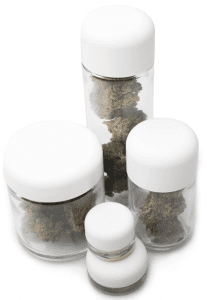Child-Resistant Packaging Required on all California Cannabis Products Beginning in 2020
December 7, 2019
By Andrew Kingsdale

Image by the Hybrid Creative. Fair Use.
California’s cannabis packaging laws have long required that cannabis and cannabis products be sold in “child-resistant” packaging, but through most of the past two years that requirement could be met by using either individual product packaging or exit package at retail sale. (Cal. Bus. & Prof. Code § 26120(a); 17 C.C.R. § 40417(c).) However, that is about to change.
California’s Bureau of Cannabis Control (BCC) regulations state: “Beginning January 1, 2020, a package containing cannabis goods shall be resealable, tamper-evident, and child resistant.” (Title 16 of the California Code of Regulations, section 5413(b).) The state’s other two primary cannabis regulators–CalCannabis Cultivation Licensing (California Department of Food & Agriculture) and Manufactured Cannabis Safety Branch (California Department of Public Health)–also require “child-resistant” packaging by January 1. (3 C.C.R. § 8212; 17 C.C.R. § 40417. )
Because the phrase “cannabis goods” is broadly defined as “cannabis, including dried flower, and products containing cannabis” (16 C.C.R. § 5000(f)), just about every individual product sold at retail (except for clones and cannabis accessories) will have to meet this new “child-resistant” packaging standard after the new year.
“Resealable” is fairly self-explanatory. “Tamper-evident” is defined as “sealed in a manner that prevents the packaging from being opened without obvious destruction of the seal.” (16 C.C.R. § 5000(w).) But what does it mean to be “child-resistant”?
Business and Professions Code § 26001(j) defines “child resistant” to mean “designed or constructed to be significantly difficult for children under five years of age to open, and not difficult for normal adults to use properly.” This definition parrots the standard for child-resistance in the federal Poison Prevention Packaging Act of 1970 (15 U.S.C. §§ 1471-1476; 16 C.F.R. §1700.1 et seq.), which is incorporated, in part, into California’s cannabis packaging regulations.
For example, BCC’s regulations define “child-resistant” packaging as including:
(i) Any package that has been certified as child-resistant under the requirements of the Poison Prevention Packaging Act of 1970 Regulations (16 C.F.R. §1700.15(b)(1)) (Rev. July 1995), which is hereby incorporated by reference.
(ii) Plastic packaging that is at least 4 mils thick and heat-sealed without an easy-open tab, dimple, corner, or flap.
(16 C.C.R. § 5303(a)(2))
Similarly, the Manufactured Cannabis Safety Branch’s regulation on “Child-Resistant Packaging Requirements” states:
(b) The following packages are considered child-resistant for purposes of this Article:
(1) Any package that has been certified as child-resistant under the requirements of the Poison Prevention Packaging Act of 1970 Regulations (16 C.F.R. §1700.15(b)(1)) (Rev. July 1995), which is hereby incorporated by reference.
(2) A bottle sealed with a pry-off metal crown cork style bottle cap, provided that the bottle contains only a single serving.
(3) Plastic packaging that is at least 4 mils thick and heat-sealed without an easy-open tab, dimple, corner, or flap, provided that the package contains a cannabis product described in subsection (a)(2) or is a cannabis product that is only a single serving.
(17 C.C.R. § 40417(b))
So aside from a few packaging types deemed de facto “child-resistant” (4 mils thick and heat-sealed plastic packaging, and pry-off metal bottle caps), to meet these new child-resistance standards companies need to understand 16 C.F.R. §1700.15(b)(1) of the Poison Prevention Packaging Act of 1970 Regulation), which states:
(b) Effectiveness specifications. Special packaging, tested by the method described in § 1700.20, shall meet the following specifications:
(1) Child-resistant effectiveness of not less than 85 percent without a demonstration and not less than 80 percent after a demonstration of the proper means of opening such special packaging. In the case of unit packaging, child-resistant effectiveness of not less than 80 percent.
How does one measure “effectiveness” to such exacting levels? In short, by testing. And the PPPA Regulations specify the testing procedures in exacting detail (including the required statement from tester to child: “YOU CAN USE YOUR TEETH IF YOU WANT TO,” 16 C.F.R. §1700.20(a)(2)(iv).)
And, assuming a cannabis product is tested and satisfies these levels of child-resistant effectiveness, then how does one ensure the package “has been certified” child-resistant (as required by CDPH and BCC)? The BCC and CDPH regulations do not say, but one thing is certain: government agencies themselves do not certify products as child-resistant. According to CDPH, the answer can be found in guidance from the U.S. Consumer Product Safety Commission (CPSC, which administers the Poison Prevention Packaging Act). Reference to this CPSC guidance suggests that California cannabis manufacturers themselves likely will have to self-certify, in a written General Certificate of Conformity (GCC), that their products are child-resistant based on testing or a reasonable testing program.
Interestingly, BCC and CDPH child-resistance regulations only incorporate that portion of the PPPA Regulations pertaining to child-resistance (16 C.F.R. §1700.15(b)(1)), but do not incorporate the very next subsection (16 C.F.R. §1700.15(b)(2)) pertaining to “Ease of Adult Opening” — including a test for senior adults, the fastest growing segment of cannabis users.
Companies also need to discern whether their packaging must be child-resistant either “for the life of the product” (multiple use, or lifetime CRP), or “only until first opened” (single-use, or initial CRP). Topicals, flower and other cannabis products intended to be inhaled “may utilize packaging that is child-resistant only until first opened, if the package is labeled with the statement ‘This package is not child-resistant after opening.’” (17 C.C.R. § 40417(a)(2), bold added.) But edibles, tinctures, and suppositories “shall be child-resistant for the life of the product,” unless each individual serving is packaged in child-resistant packaging. (17 C.C.R. § 40417(a)(1), emphasis added.)
Stay tuned to our blog for future updates regarding packaging and labeling rules for cannabis operators in California.
This information is provided as an educational public service and is not intended as legal advice. For specific legal questions regarding cannabis and hemp laws and regulations in California, please contact the Law Offices of Omar Figueroa at (707) 829-0215 or info@omarfigueroa.com to schedule a confidential consultation.
